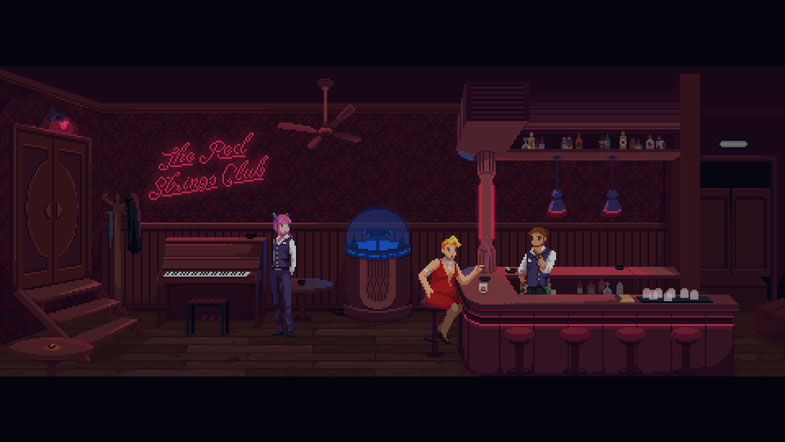The Red Strings Club transports you into a gritty, 1980’s-inspired cyberpunk future to solve a mystery that asks more questions about morality and human nature than it answers. The nostalgic feel isn’t overpowering or gimmicky; rather, the setting could pass as something straight out of the Blade Runner universe, yet maintains its own style and originality. Modern technology is referenced, but the backbone of the plot takes your curiosity for a ride with its fantastical sci-fi elements. Add just a dash of that decades-old pixel art aesthetic, and you have a solid entry into the cyberpunk genre.
The Red Strings Club is one long philosophical debate.

The thing Red Strings does best is make you think. This can probably be considered part of the visual novel genre (you either hate them or you love them), but it doesn’t make you feel bored or railroaded at any point. Your choices feel like they matter, even if that’s just an illusion.
It would be more satisfying if your choices did matter more in the end, but the reason they don’t is well justified. The few actions that do have a significant impact don’t manifest until much later, which is an excellent design choice, since the first scene opens with the protagonist asking, “I wonder when my fate was sealed?” That, plus the fact that the opening is clearly a flash forward to the end, are clear indications that no matter what you do you will end up in the same place. A second playthrough confirms this, as a very different path leads you to the same inevitable conclusion.
Interestingly, this isn’t all chalked up to the abstract concept of “fate,” but is rather given a sci-fi explanation via a nice plot twist. All the themes come together perfectly as you struggle against overwhelming forces like corporate power, technology, and human nature. You initially take a strong stand against social control, but as you fight against it, you realize that your battle is just another form of the same thing. It then becomes a question of how to remain the hero you think you are when the villain arguably holds similar views..
Red Strings also does a nice job of delivering an overall message through its plot, despite giving you the illusion that you are deciding your philosophy for yourself. This isn’t anything particularly overbearing, but rather a lightly progressive message that fits the future setting. Red Strings has faced some criticism for a minor plot detail that some view as non-inclusive (and if you’re interested, this is something worth looking into and thinking about for yourself), however, the messages and overall tone seem to be made in good faith. For example, the protagonists are gay but it doesn’t come off as an effort to score minority points, and if you choose dialogue options like, “What do you mean? Women aren’t mistreated these days,” you are called an idiot.
Dialogue is the focus, but every element is perfectly polished.
Well, almost every element. Ironically, for a game so focused on words, the one flaw is the occasional typo. Otherwise, though, everything fits together perfectly.
The score couldn’t be any more fitting. Melancholy piano gives way to cyberpunk electronic music in exactly the right places. The atmosphere of each scene is complemented extremely well by the catchy soundtrack. The small details are also given careful attention: the music loops no matter how long you wait, yet merges seamlessly with the next song when the plot progresses.
The graphics similarly serve the tone of Red Strings. Thankfully, they aren’t meant to be the sole attraction by evoking nostalgic feelings, and the low resolution never interferes with the story. The result is immersive and genre-appropriate.
Highly original mechanics carry the plot forward.

The final piece of the puzzle is the gameplay. Much of this involves selecting dialogue, but there are also unique minigame-like activities that serve the plot incredibly well. This is counterintuitive, because Red Strings would be boring if the sole focus was making pottery or mixing drinks. What separates it from a money-grabbing app called, say, Pottery Lord, is that these mechanics serve as narrative tools.
These strange minigames provide meaning that transcends the action. You aren’t just spinning pottery on a wheel: you are forming behavior-influencing organs to implant into people and improve their lives. You aren’t simply mixing drinks: you are adding just the right amount of ingredients to evoke certain emotions in people so they will give you more information. (Although, I have to say it was a little strange that most of the drinks were just a cup of two different hard liquors. I can’t imagine a glass of whiskey and tequila would be terribly appealing, but the customers seemed to love it.)
Whenever these minigames start to get a little dull, Red Strings changes up the formula. For example, you get treated to an enjoyable social engineering section where you impersonate corporate employees and call around to get information.
All of these elements are nearly unprecedented, and the way they are incorporated is especially unique. My only wish is that the playthrough could have lasted longer. At four hours, it’s satisfying, but I want more.
The Verdict: Excellent
The Red Strings Club is a highly original and well-polished title. The cyberpunk mystery is deeply satisfying, with a heavy story that explores interesting ethical questions and the gameplay mechanics, score, and a visual aesthetic that complement the plot wonderfully. The only real flaw of this title is a playthrough length that leaves you wanting more.


